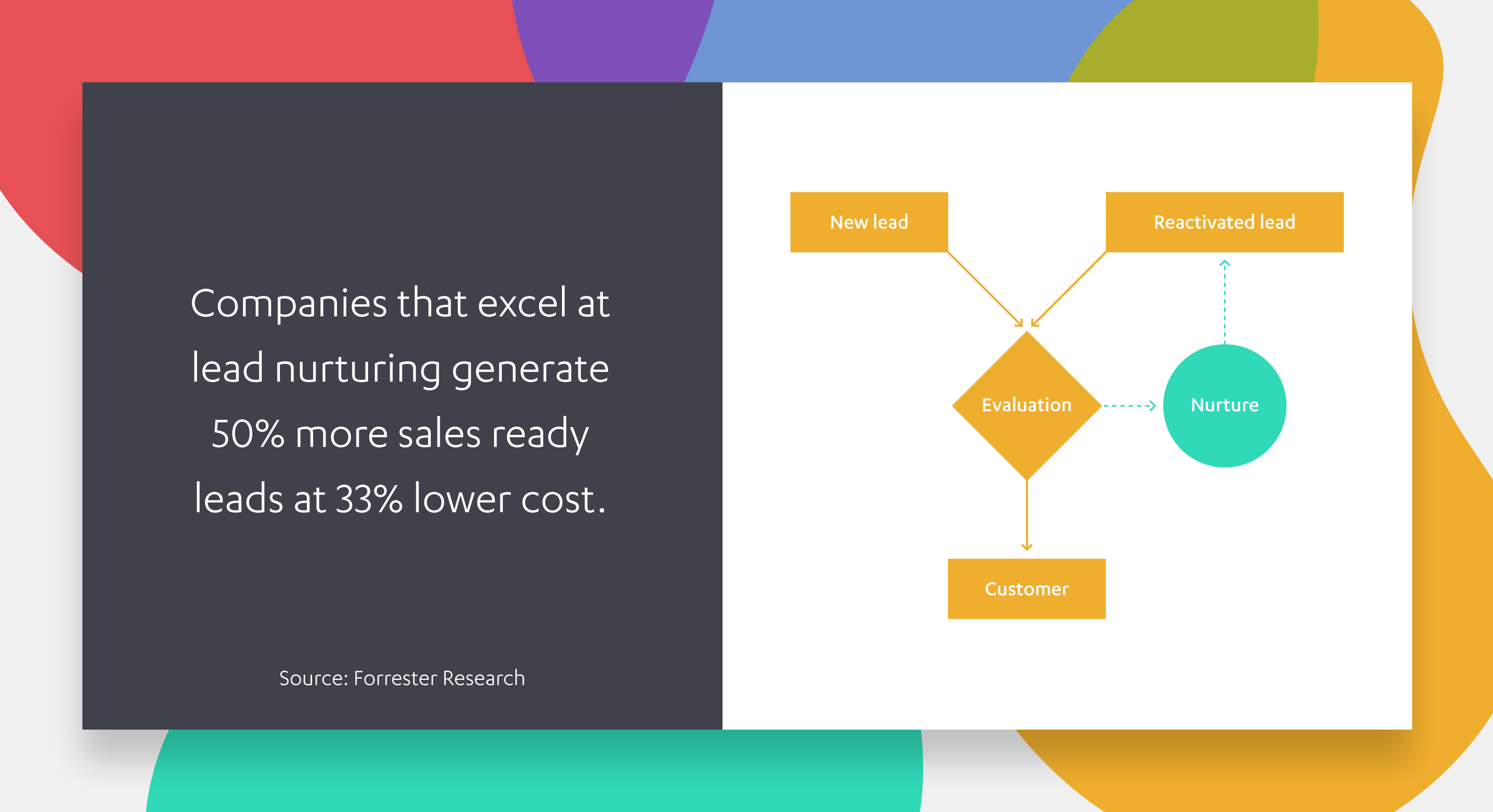January 1, 0001
ROI of lead nurturing
Lead nurturing helps you build a relationship with potential customers and accelerate their buying journey. By staying in touch regularly, you ensure that your brand comes to mind when they’re ready to buy.
Most marketing leads never convert into customers. Lack of lead nurturing is the most common cause of this poor performance.
How to Calculate the ROI of Lead Nurturing
Lead nurturing has many benefits:
- Accelerating your sales cycle
- Educating people who want to learn more but aren’t ready to buy
- Growing your revenue by reactivating cold leads and creating new sales opportunities
- Increasing awareness for your brand or product
- Increasing lead-to-customer conversion rates
- Generating more qualified leads, while driving down cost
Despite these benefits, optimizing your first nurture journey can take some time. That’s why it’s important to start with a quantified return-on-investment (ROI) goal, against which you can measure your success.
The two main drivers of calculating expected ROI from lead nurturing are your lead-to-customer conversion rate and your average sales price (ASP).
You’ll want to forecast ROI separately for nurturing new leads and reactivating stale leads.
Calculate the ROI of nurturing new leads
The ROI of lead nurturing comes from the revenue generated from nurtured leads, compared to those who are not nurtured.

How to calculate the ROI of nurturing new leads
Calculate your current monthly revenue from new leads
Take the number of new leads you bring in each month. Multiply that number by the rate at which you convert them (currently), and then multiply that by the average amount each customer spends. It looks like this:
New Leads x Current Conversion Rate x Current ASP = Monthly Revenue from New Leads
For example, if your baseline lead-to-customer conversion rate is 10%, and you attract 500 new leads a month, that’s 50 new customers each month. With an ASP of $100 per customer, that converts to $5,000 in new revenue for that month.

Calculate the new monthly revenue generated from nurtured leads
When done well, lead nurturing should increase your conversion rate by at least 25% and your ASP by 40%.
New Leads x Increased Conversion Rate x Increased ASP = Monthly Revenue from New Nurtured Leads
Using the above example, lead nurturing should increase our conversion rate from 10% to 12.5% and our ASP from $100 to $140. If 12.5% of 500 leads convert, that’s an additional 12.5 customers for that month. At an ASP of $140 per customer, that’s $8,750 in surplus revenue.
Calculate the difference between the two
Take your estimated monthly revenue after nurture and subtract the monthly revenue you currently generate from new leads each month. The difference is your predicted lead nurturing return on investment.
In our example, we subtract $5,000 (monthly revenue from new leads) from $8,650 (monthly revenue from new nurtured leads): $8,650 – $5,000 = $3,750
Lead nurturing gives us an extra $3,750 dollars per month or $45,000 in incremental revenue per year. That’s a 75% increase in total revenue just through effective nurturing of new leads.
Calculate the ROI of reactivating old leads
What about the costly leads that are sitting idle in your database? They clearly had a relevant need or interest in your solution in the past. Yet, apart from sending them occasional newsletters, they likely haven’t heard from you in months (or even years). If you aren’t actively nurturing these leads, you’re leaving money on the table.

How to calculate the ROI of reactivating stale leads
The ROI of reactivating old leads is relatively simple. It’s the revenue that you generate from stale leads in your database, who otherwise wouldn’t have converted. Let’s walk through it.
Estimate how many leads you’ll re-engage each year
Armed with a solid nurture journey, you can conservatively expect to reactivate 2-5% of your contact database.
Let’s say you’re sitting on 50,000 cold leads. If you can reactivate just 2% of those, that’s an additional 1,000 leads per year.
Calculate how many of these leads will convert into new customers.
It may take longer for these leads to surface, but when they do, they’re likely further along in the buyer’s journey — leading to higher conversion rates. It’s safe to estimate that your nurtured leads will convert at three times your baseline.
Continuing with the example above, our conversion rate for these leads would be 30%, three times more than the 10% conversion rate we see with new leads. That’s an additional 300 customers per year.
Now multiply those new customers by the ASP
Remember: Nurtured leads spend about 40% more than new leads. With an ASP of $140, those 300 customers contribute $42,000 in additional revenue per year: 1,000 (reactivated leads) X .3 (conversion rate) X 140 (ASP) = $42,000 (revenue from reactivated revenue).
The potential ROI of lead nurturing
In the examples above, we’ve shown how a company that generates 500 leads per month, with an ASP of $100, and 50,000 contacts in their database, can generate $87,000 in revenue each year from new and reactivated leads through lead nurturing.
While this is a terrific result by itself, a less tangible (but equally valuable) outcome is that you’ve educated your customers. And nurtured leads that become customers are your best customers. They tend to extract more value from your product, purchase more often, spend more, stay customers for longer, and drive more referrals.
If you haven’t done any nurturing in the past, you’ll likely see an initial spike in reactivated leads when you launch your first journey. As new leads go cold, you’ll have an ever-growing base of cold leads to reactivate — meaning the ROI of nurturing cold leads is an ongoing process.
Keen to get started? Read our 5-step guide to lead nurturing.












